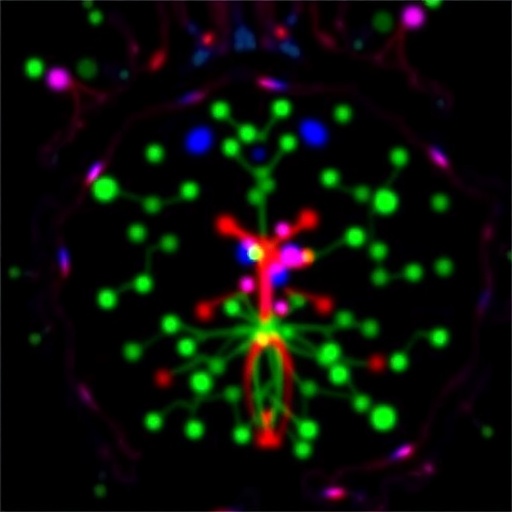In the ever-evolving landscape of pharmacology and toxicology, the need for precise and innovative methodologies to quantify drugs and investigate their interactions is paramount. A recent groundbreaking study, conducted by a team of researchers led by Zhou et al., has introduced a state-of-the-art approach utilizing Ultra-Performance Liquid Chromatography coupled with Tandem Mass Spectrometry (UPLC-MS/MS) to quantify asciminib, a drug of considerable interest in the realm of oncology. This validation not only addresses the determination of asciminib in biological matrices but also explores its pharmacokinetic interactions and metabolic stability when combined with shikonin, a compound known for its rich array of pharmacological properties.
Asciminib, a potent BCR-ABL inhibitor, has emerged as a vital component in the treatment of certain types of leukemia. The increasing demand for effective therapeutic strategies has pushed researchers to explore novel approaches that can enhance the efficacy of existing treatments. Understanding the pharmacokinetics of asciminib is crucial, particularly when considering its interaction with other compounds like shikonin, which has demonstrated anti-cancer activity and other health benefits. Zhou and colleagues embarked on this exploration to elucidate the potential synergistic effects that could arise from this combination.
The methodology employed in this study is particularly noteworthy. The researchers meticulously developed and validated a UPLC-MS/MS method that is not only sensitive but also robust and reliable for quantifying asciminib. This advanced technique stands out due to its high resolution and precision, allowing for the accurate detection of low concentrations of the drug in complex biological matrices such as plasma. The validation process involved a series of rigorous tests to ensure the method met stringent criteria for accuracy, precision, specificity, and reproducibility.
In their validation process, Zhou et al. utilized a variety of biological samples, establishing a comprehensive framework for the application of their method. This approach significantly enhances the potential for clinical applications, as reliable data on asciminib’s concentration levels can facilitate better treatment regimens and individualized patient care. Importantly, the study also investigates the influence of shikonin on the pharmacokinetic profile of asciminib, potentially uncovering new therapeutic avenues for enhancing treatment outcomes in patients with drug-resistant forms of leukemia.
The implications of this research extend beyond mere quantification. By examining the metabolic stability of asciminib in the presence of shikonin, the researchers are addressing a critical gap in knowledge regarding how these compounds may interact within the body. Understanding these interactions is essential not only for predicting therapeutic efficacy but also for minimizing adverse effects that may arise from concomitant use. The findings could lead to an informed approach in clinical settings, ensuring that healthcare providers can make evidence-based decisions when prescribing asciminib, especially in combination therapies.
Analytical advancements such as the UPLC-MS/MS method are imperative in modern pharmacological research. They provide the foundation for comprehensive pharmacokinetic studies, enabling scientists to discern intricate details about how drugs are metabolized, excreted, and how they interact with various biological pathways. This level of insight is crucial for the development of new drugs and combination therapies aimed at improving patient outcomes, particularly in challenging conditions like cancer where treatment resistance is common.
Interestingly, the study by Zhou et al. also highlights the importance of validating analytical methods for drug quantification in different populations and under various clinical conditions. As each patient’s metabolic profile can differ significantly based on a myriad of factors including genetics, age, and comorbidities, a validated method ensures that the data gathered is applicable and reliable across diverse clinical contexts. Carefully designed pharmacokinetic studies such as this one can inform dosing strategies and therapeutic decisions, paving the way toward more personalized medicine.
Furthermore, the exploration of combinations like asciminib and shikonin may reveal not just enhanced efficacy but also the possibility of reducing side effects. By pairing asciminib with a compound that has its own therapeutic benefits, researchers may discover strategies that allow for lower dosages of each drug, thereby potentially mitigating the risk of adverse reactions. This synergistic approach aligns well with the ongoing shift in the pharmaceutical community towards combination therapies, especially in the treatment of complex diseases like cancer.
In a world where drug resistance has emerged as a significant barrier to effective treatment, the research led by Zhou et al. is a timely contribution to the field. The methodological advancements and findings presented in this study not only serve as a stepping stone for future research but also underscore the necessity for continual advancements in drug quantification techniques. As new compounds and treatment regimens are developed, the need for precision in measurement and understanding of drug interactions will remain a critical focus for researchers and clinicians alike.
The successful validation of the UPLC-MS/MS method for asciminib sets a precedent for future studies exploring similar compounds and interactions. This research could inspire additional studies aiming to understand the pharmacokinetics of other potential drug combinations, fostering an environment of innovation in drug development. Concurrently, it draws attention to the importance of collaborative efforts across disciplines to tackle the complex challenges posed by drug interactions and metabolic considerations in pharmacotherapy.
As the findings beckon further exploration, the pharmaceutical industry, healthcare providers, and patients alike stand to benefit from enhanced understanding and application of such methodologies in clinical practice. This study not only enriches the existing body of knowledge but also paves the way for innovative strategies that could ultimately improve treatment outcomes for patients battling difficult and drug-resistant conditions.
In conclusion, Zhou et al.’s study exemplifies the critical intersection of advanced analytical methodologies and clinical application. The development and validation of a sensitive UPLC-MS/MS method for asciminib, alongside probing its interactions with shikonin, marks a significant stride in pharmacokinetic research. As we continue to unveil the complex interactions within biological systems, studies like this will play a vital role in shaping the future of drug therapy and patient management in oncology.
Subject of Research: Combination therapy of asciminib and shikonin using UPLC-MS/MS quantification.
Article Title: Development and validation of a UPLC-MS/MS method for the quantification of asciminib and its pharmacokinetic interaction and metabolic stability with shikonin.
Article References:
Zhou, C., Xia, H., Hu, Y. et al. Development and validation of a UPLC-MS/MS method for the quantification of asciminib and its pharmacokinetic interaction and metabolic stability with shikonin.
BMC Pharmacol Toxicol (2025). https://doi.org/10.1186/s40360-025-01049-0
Image Credits: AI Generated
DOI:
Keywords: UPLC-MS/MS, asciminib, shikonin, pharmacokinetics, combination therapy, drug interaction, metabolic stability, cancer treatment, analytical methods.
Tags: asciminib pharmacokineticsBCR-ABL inhibitor researchbiological matrix analysis techniquescancer treatment innovationsmetabolic stability assessmentnovel drug combination strategiesoncology drug developmentpharmacological interactions studypharmacology and toxicology advancementsshikonin anti-cancer propertiestandem mass spectrometry applicationsUPLC-MS/MS method for drug quantification





